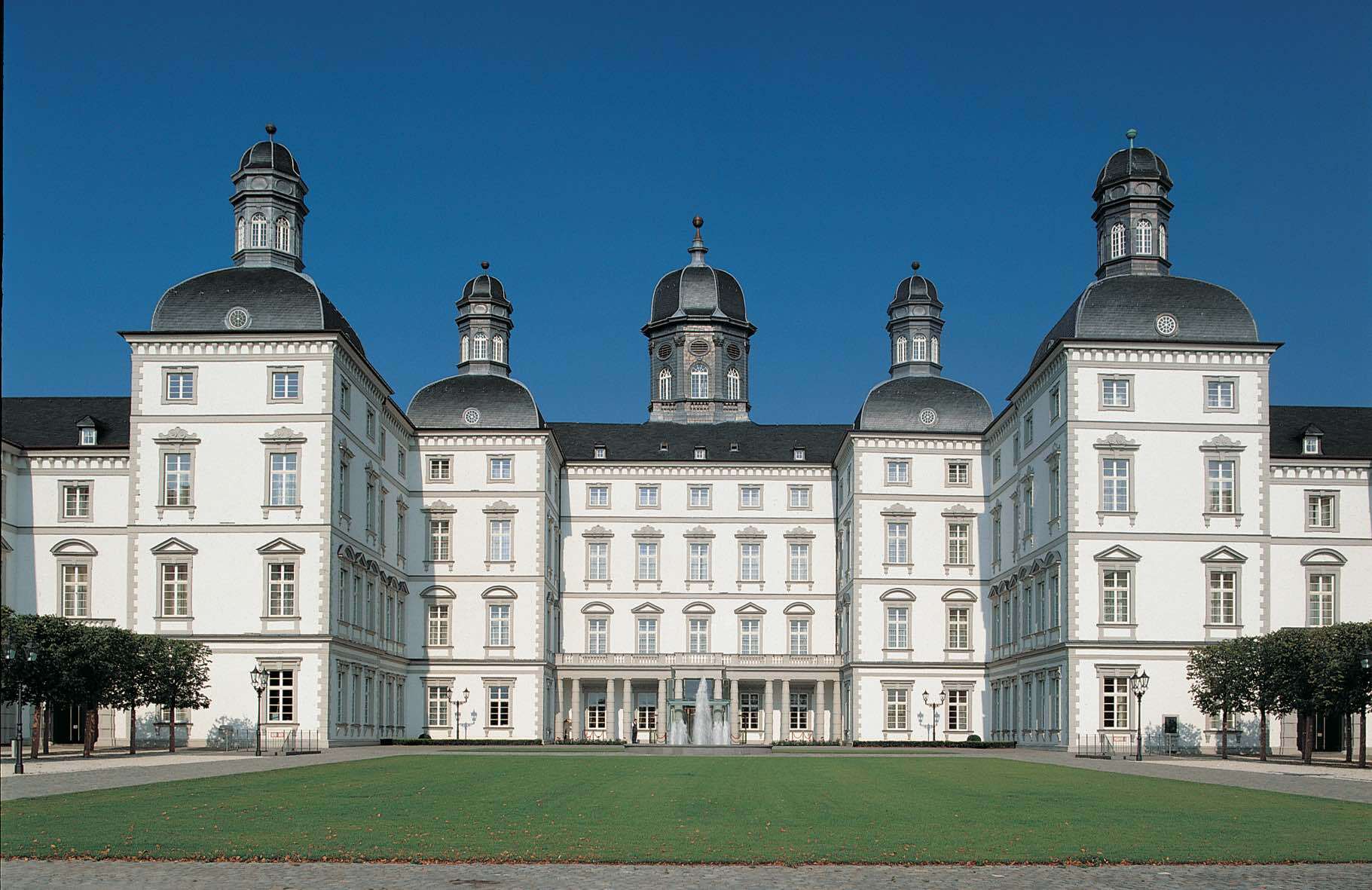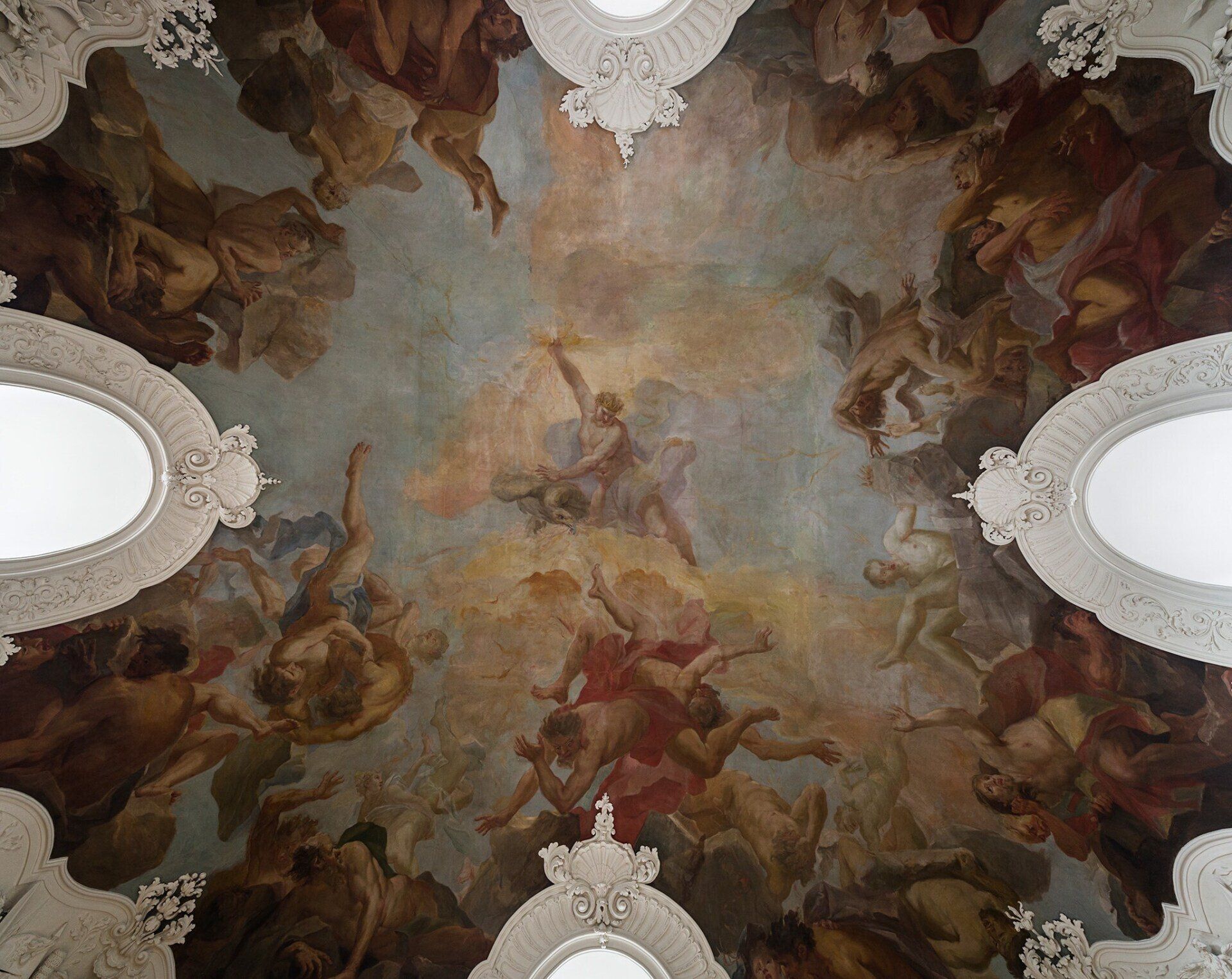THE EVENTFUL HISTORY
OF SCHLOSS BENSBERG
26. October 2021

Althoff Grandhotel Schloss Bensberg
©Klaus Lork
Schloss Bensberg in Bergisch Gladbach, NRW, from the Althoff Hotel Collection, is known worldwide as a luxury hotel. The magnificent baroque architecture has made it distinctive and an attraction for guests from all over the world - the Cologne airport is only 15 minutes away.
The castle has a 3-star restaurant run by Germany's chef Joachim Wissler. It also has an art collection built up over decades with works by Markus Lüpertz, Antoni Tàpies, Joseph Beuys, Georg Baselitz, A.R. Penck, Wilhelm Beestermöller, Wolfgang Stahr and Salvadore Dalí.
Until this happened, the castle experienced a very eventful history, which will be outlined here. Schloss Bensberg was planned by the Kurfürst (Elector) Johann Wilhelm for his wife Princess Anna Maria Louisa de' Medici, but unfortunately the couple did not live to see its completion. After the prince's death, other priorities were set and over the course of time the unfinished complex was put to many different uses, even misappropriated.
THE HISTORY OF SCHLOSS BENSBERG
Schloss Bensberg was built between 1703 and 1710 as a hunting lodge by Matteo Alberti for the Kurfürst Johann Wilhelm (1658-1716), known as Jan Wellem. The architecture of the building makes it a symbol of the absolutist form of rule.
A glance at the Kurfürsts‘s curriculum vitae explains how Jan Wellem gained access to the intellectual and cultural values of his time and came to know history, politics, art and philosophy as forces that are mutually dependent (architecture, fine arts, literature, philosophy, music). In his youth, in fact, he had the opportunity to visit the courts of Louis XIV of France (1643-1715), Charles II of England (1660-1685), the Italian courts and the Viennese court of Emperor Leopold I. (1658-1705).
In his later reign, as a cosmopolitan, art-loving prince with close family ties to the imperial house, he endeavoured to emphasise his political position in Germany. Thus he was able to show his power by building Schloss Bensberg.
PLANNING AND CONSTRUCTION OF SCHLOSS BENSBERG
Even as a child, Kurfürst Johann Wilhelm of the Palatinate came with his parents and his many siblings to the Old Palace in Bensberg every autumn to hunt. The reason for the new building in Bensberg was his wife, Anna Maria Louisa de' Medici, who had grown up as an Etrurian princess in the Palazzo Pitti in Florence.
Even before 1700, she asked her uncle, Cardinal Francesco Maria de' Medici, for the plans of his Villa Lapeggi near Florence, which she was enthusiastic about. The villa was a 3-winged complex with about 3000 square meter of living space.
The "Kurfürst von der Pfalz (Prince Elector of the Palatinate)", popularly known as Jan Wellem, who on his cavalier tour through Europe as a youth, had twice spent long periods at the court of the Sun King in Versailles, and had grander plans for his hunting lodge in Bensberg. After 1700, he engaged the Venetian Count Matteo d'Alberti as architect. In 1703, the deputy architect Aloisius Bartoli presented a wooden model of the New Palace.

Portrait of Anna Maria Louisa de' Medici
©Althoff collection Grandhotel Schloss Bensberg
1705 CONSTRUCTION BEGINS
During the construction work, which began in 1705, the plans were changed several times. Planned gable roofs, on the central wing in triangular form with an inscription addressed to Diana, the goddess of the hunt, as well as round gables at the ends of the wings, were not built. The inner courtyard was doubled in size. Larger-than-life, gilded statues were planned for the roof gables and wall pillars, with a depiction of Diana in the middle of the central wing, for example. In the inner courtyard, equestrian statues of the owner and his father were planned. The central wing, initially planned as a three-storey building, would not have been visible from the west. Therefore, the building was given a fourth storey and the five characteristic octagonal towers.
Since the interior work in large parts of the main building was also not finished, the ruling couple never occupied their middle wing and the Kurfürst never occupied his north wing. Unfortunately, Jan Wellem was unable to leave Düsseldorf for reasons of illness in the last years of his life, and he was unable to see the progress of construction on the New Palace. The intended hunting parties did not celebrate in the south wing. Servants did not populate the upper floors. Almost the entire palace stood empty until 1793.
1716 - DEATH OF THE KURFÜRST
After the death of the Kurfürst , building work ceased in 1716. Thousands of workers and artists were dismissed. Many had come from the Walloon part of the Spanish Netherlands, which had been occupied by France during the War of the Spanish Succession. Some of them married in Bensberg. Old Bensbergers still call their houses in the Milchborntal and on the Hardtweg "France" or "Little France".
The chapel built on the south-east corner was given a roof with a large round gable, but was never used. The single-storey outbuildings also had roofs. Pictures for the painting gallery planned for the northern antechamber, which was never installed, had already been deposited in the palace.
Only a few visitors came and wrote down their impressions. Goethe admired 1774 especially the paintings from the hunting cycle by Jan Weenix.
1793 - A HOSPITAL
Bensberg Palace was used as a military hospital by the Habsburgs in 1793 and by the French in 1813. As a result of the Congress of Vienna, Schloss Bensberg came to Prussia in 1815, initially with a Prussian military hospital.
1838 to 1841 - THE FIRST MAJOR RECONSTRUCTION
Buildings that were dilapidated and neglected were demolished. The two outbuildings were demolished except for the large vaulted cellars, on which two-storey extensions were built. The open arcades in the wings on the inner courtyard were closed by windows and doors. On the ground floor of the north wing, the load-bearing walls were removed. In the large dining hall there, massive columns now provided sufficient statics. The altars - columned porches that served as balconies on the 1st floor - at the wing ends and in front of the central section were dilapidated. Demolition was cheaper than repair. A Protestant chapel was built in front of the middle wing. The greatest intervention in the interior was the removal of the main staircases with their stucco work, valuable statues and the frescoes by Pellegrini and Zanetti on the walls and undersides of the staircases.
Since the horse-drawn carts with the building materials could not manage the steep path rising from the west, a hollow path was created there and half the inner courtyard was sloped. The entrance gate was lowered by five metres.
For almost eight decades, Schloss Bensberg was a cadet institution. During this time, the palace park was purchased for flats and gardens for the administration. More than half of the more than 3000 cadets trained at Bensberg Palace became officers loyal to the king, and probably more than a hundred of them became generals. Most of the cadets and all twenty commanders of the institution were Protestants, like the Prussian royal family.

Historical Schloss Bensberg
©Althoff collection Grandhotel Schloss Bensberg
1934 - NEW PURPOSE
After the occupation had left, the municipal administration, district administration and vocational school moved into the castle in 1922. The planning of a Jesuit boarding school in the castle led to a religious war in the Rhineland. Protestants from Bensberg did not want their children to be taught by Jesuits and feared that they would no longer be allowed to use the chapel. Until 1934, 93 families lived here.
1934 - 1937 - THE SECOND MAJOR RECONSTRUCTION
The architect Werner Dobisch rebuilt the Bensberg Palace into a showpiece. Many of the sins of the first reconstruction could not be repaired. Only the chapel built in front of the middle wing was demolished. It was replaced by a large altar as in the 18th century.
At the beginning of March 1942, the roof truss of the north wing and the tower above the cadet memorial room with Pellegrini's dome fresco "Fall of the Phaeton" burnt down.

Fresco in the castle
©Althoff collection Grandhotel Schloss Bensberg

Althoff collection Grandhotel Schloss Bensberg
Zanetti Ceiling
©Althoff collection Grandhotel Schloss Bensberg

Der gestürzte Krieger von Markus Lüpertz
The Fallen Warrior by Markus Lüpertz
©Althoff collection Grandhotel Schloss Bensberg
AFTER THE SECOND WORLD WAR
After the end of the war, the castle again became barracks for occupying troops. The last of these were the Belgian troops, and from 1955 the Belgian Nato. After the troops moved from Bensberg to Dellbrück and there was a fire at Venauen Castle in Rösrath in 1964, the Flemish section of the "Royal Athenaeum" there moved to Bensberg Castle as a boarding school. When the Flemish girls had also moved into their boarding school after the boys in 1991, the Belgians only used the dining hall in the north wing and the school pavilions in the park.
SCHLOSS BENSBERG E.V.
SCHLOSS BENSBERG e.V., founded in 1995, represented the interests of the citizens of Bensberg the interests of the citizens of Bensberg during the sales negotiations and helped to give the castle a permanent purpose in keeping with its imposing appearance.
At the beginning of 1997, the Aachener und Münchener life insurance company bought Schloss Bensberg, renovated the building and converted it into a hotel. The Grand Hotel Schloss Bensberg, a member of the Althoff Hotel Collection, opened in spring 2000.
Althoff Grandhotel Castle Bensberg
Kadettenstrasse, 51429 Bergisch Gladbach, Germany
www.schlossbensberg.com
By G. 26.


